A Review on Ergonomics in Agriculture. Part II: Mechanized Operations
Abstract
:1. Introduction
2. Spinal Anatomy, Biomechanics and Health Effects of Whole-Body and Hand-Arm Transmitted Vibration
2.1. Spinal Anatomy
2.2. Biomechanics and Physiological Effects of Vibration Exposure
3. Methods
3.1. Identification of Relevant Studies
3.2. Methodological Quality Assessment
3.3. Strength of Evidence of Potential Risk Factors Causing MSDs
4. Results
4.1. Preliminary Data Visualization Analysis
4.1.1. Geographical Distribution of All Contributing Research Organizations
4.1.2. Distribution of All Contributing International Journal Papers
4.1.3. Keyword Information Clustering
4.2. Brief Review of Literature Classified into Agricultural Machinery Types
4.2.1. Tractor
4.2.2. Quad Bike
4.2.3. Grass Trimmer
4.2.4. Handheld Olive Beater
4.2.5. Power Tiller
4.2.6. Rice Plowing Machine
4.2.7. Agricultural Aircraft
4.2.8. Various agricultural machines with driving seats
4.3. Methodological Quality of the Reviewed Articles
4.4. Synopsis of the Methodologies, Ergonomic Interventions and Risk Factors for the Development of MSDs
5. Discussion
Study Strengths and Limitations
Author Contributions
Funding
Conflicts of Interest
References
- Kirkhorn, S.R.; Schenker, M.B. Current Health Effects of Agricultural Work: Respiratory Disease, Cancer, Reproductive Effects, Musculoskeletal Injuries, and Pesticide–Related Illnesses. J. Agric. Saf. Health 2002, 8, 199–214. [Google Scholar] [CrossRef] [PubMed]
- Rautiainen, R.H.; Reynolds, S.J. Mortality and Morbidity in Agriculture in the United States. J. Agric. Saf. Health 2002, 8, 259–276. [Google Scholar] [CrossRef]
- Lee, W.J.; Colt, J.S.; Heineman, E.F.; McComb, R.; Weisenburger, D.D.; Lijinsky, W.; Ward, M.H. Agricultural pesticide use and risk of glioma in Nebraska, United States. Occup. Env. Med. 2005, 62, 786–792. [Google Scholar] [CrossRef] [PubMed] [Green Version]
- Meyers, J.M.; Miles, J.A.; Faucett, J.; Janowitz, I.; Tejeda, D.G.; Kabashima, J.N. Ergonomics in agriculture: Workplace priority setting in the nursery industry. Am. Ind. Hyg. Assoc. J. 1997, 58, 121–126. [Google Scholar] [CrossRef]
- Fathallah, F.A. Musculoskeletal disorders in labor-intensive agriculture. Appl. Erg. 2010, 41, 738–743. [Google Scholar] [CrossRef] [PubMed]
- Miller, B.J.; Fathallah, F.A. The Effects of a Stooped Work Task on the Muscle Activity and Kinematics of the Lower Back. Proc. Hum. Factors Erg. Soc. Annu. Meet. 2006, 50, 1284–1288. [Google Scholar] [CrossRef]
- Benos, L.; Tsaopoulos, D.; Bochtis, D. A Review on Ergonomics in Agriculture. Part I: Manual Operations. Appl. Sci. 2020, 10, 1905. [Google Scholar] [CrossRef] [Green Version]
- Bochtis, D.D.; Sørensen, C.G.C.; Busato, P. Advances in agricultural machinery management: A review. Biosyst. Eng. 2014, 126, 69–81. [Google Scholar] [CrossRef]
- European Parliament. Directive 2002/44/EC of the European Parliament and of the Council of 25 June 2002 on the Minimum Health and Safety Requirements Regarding the Exposure of Workers to the Risks Arising from Physical Agents (Vibration); European Agency. Available online: https://eur-lex.europa.eu/legal-content/EN/ALL/?uri=CELEX%3A32002L0044 (accessed on 29 January 2020).
- Cecchini, M.; Colantoni, A.; Monarca, D.; Longo, L.; Riccioni, S. Reducing the Risk From Manual Handling of Loads in Agriculture: Proposal and Assessment of Easily Achievable Preventive Measures. Proc. Chem. Eng. Trans. 2017, 58. [Google Scholar] [CrossRef]
- Fathallah, F.A.; Miller, B.J.; Miles, J.A. Low Back Disorders in Agriculture and the Role of Stooped Work: Scope, Potential Interventions, and Reearch Needs. J. Agric. Saf. Health 2008, 14, 221–245. [Google Scholar] [CrossRef]
- Milosavljevic, S.; McBride, D.I.; Bagheri, N.; Vasiljev, R.M.; Carman, A.B.; Rehn, B.; Moore, D. Factors associated with quad bike loss of control events in agriculture. Int. J. Ind. Erg. 2011, 41, 317–321. [Google Scholar] [CrossRef]
- Azmir, N.A.; Ghazali, M.I.; Yahya, M.N.; Ali, M.H. Hand-arm vibration disorder among grass-cutter workers in Malaysia. Int. J. Occup. Saf. Erg. 2016, 22, 433–438. [Google Scholar] [CrossRef] [PubMed]
- Chaturvedi, V.; Kumar, A.; Singh, J.K. Power tiller: Vibration magnitudes and intervention development for vibration reduction. Appl. Erg. 2012, 43, 891–901. [Google Scholar] [CrossRef] [PubMed]
- Hao, K.Y.; Ripin, Z.M. Nodal control of grass trimmer handle vibration. Int. J. Ind. Erg. 2013, 43, 18–30. [Google Scholar] [CrossRef]
- Bovenzi, M. Health effects of mechanical vibration. Proceedings of the Giornale Italiano di Medicina del Lavoro ed Ergonomia 2005, 27, 58–64. [Google Scholar]
- Bovenzi, M. The hand-arm vibration syndrome: (I) the clinical picture, exposure-response relationship and exposure limits. Med. Lav. 1999, 90, 547–555. [Google Scholar]
- Langer, T.H.; Ebbesen, M.K.; Kordestani, A. Experimental analysis of occupational whole-body vibration exposure of agricultural tractor with large square baler. Int. J. Ind. Erg. 2015, 47, 79–83. [Google Scholar] [CrossRef]
- Kim, J.H.; Dennerlein, J.T.; Johnson, P.W. The effect of a multi-axis suspension on whole body vibration exposures and physical stress in the neck and low back in agricultural tractor applications. Appl. Erg. 2018, 68, 80–89. [Google Scholar] [CrossRef]
- Servadio, P.; Marsili, A.; Belfiore, N.P. Analysis of driving seat vibrations in high forward speed tractors. Biosyst. Eng. 2007, 97, 171–180. [Google Scholar] [CrossRef]
- Thomsen, G.F.; Johnson, P.W.; Svendsen, S.W.; Kryger, A.I.; Bonde, J.P.E. Muscle fatigue in relation to forearm pain and tenderness among professional computer users. J. Occup. Med. Toxicol. 2007, 2. [Google Scholar] [CrossRef] [Green Version]
- Cecchini, M.; Bedini, R.; Mosetti, D.; Marino, S.; Stasi, S. Safety Knowledge and Changing Behavior in Agricultural Workers: An Assessment Model Applied in Central Italy. Saf. Health Work 2018, 9, 164–171. [Google Scholar] [CrossRef] [PubMed]
- Mehta, C.R.; Gite, L.P.; Pharade, S.C.; Majumder, J.; Pandey, M.M. Review of anthropometric considerations for tractor seat design. Int. J. Ind. Erg. 2008, 38, 546–554. [Google Scholar] [CrossRef]
- Shapiro, I.M.; Risbud, M.V. Introduction to the structure, function, and comparative anatomy of the vertebrae and the intervertebral disc. In The Intervertebral Disc: Molecular and Structural Studies of the Disc in Health and Disease; Springer: Vienna, Austria, 2014; pp. 3–15. ISBN 9783709115350. [Google Scholar]
- Gite, L.P.; Yadav, B.G. Anthropometric survey for agricultural machinery design. An Indian case study. Appl. Erg. 1989, 20, 191–196. [Google Scholar] [CrossRef]
- Seidel, H.; Blüthner, R.; Hinz, B. Application of finite-element models to predict forces acting on the lumbar spine during whole-body vibration. Clin. Biomech. 2001, 16. [Google Scholar] [CrossRef]
- Pope, M.; Wilder, D.; Magnusson, M. Possible mechanisms of low back pain due to whole-body vibration. J. Sound. Vib. 1998, 215, 687–697. [Google Scholar] [CrossRef]
- El-Khatib, A.; Guillon, F. Lumbar intradiscal pressure and whole-body vibration–first results. Clin Biomech. 2001, 16, S127–S134. [Google Scholar] [CrossRef]
- Matsumoto, Y.; Maeda, S.; Oji, Y. Influence of Frequency on Difference Thresholds for Magnitude of Vertical Sinusoidal Whole-Body Vibration. Ind Health. 2002, 40, 313–319. [Google Scholar] [CrossRef] [Green Version]
- Mansfield, N.; Holmlund, P.; Lundstrom, R. Apparent mass and absorbed power during exposure to whole-body vibration and repeated shocks. J. Sound Vib. 2001, 248, 427–440. [Google Scholar] [CrossRef]
- Hulshof, C.; Veldhuijzen van Zanten, B. Whole-body vibration and low-back pain—A review of epidemiologic studies. Int. Arch. Occup. Env. Health 1987, 59, 205–220. [Google Scholar] [CrossRef]
- Jensen, M.C.; Brant-Zawadzki, M.N.; Obuchowski, N.; Modic, M.T.; Malkasian, D.; Ross, J.S. Magnetic resonance imaging of the lumbar spine in people without back pain. N. Engl. J. Med. 1994, 331, 69–73. [Google Scholar] [CrossRef] [Green Version]
- Calvo, A.; Romano, E.; Preti, C.; Schillaci, G.; Deboli, R. Upper limb disorders and hand-arm vibration risks with hand-held olive beaters. Int. J. Ind. Erg. 2018, 65, 36–45. [Google Scholar] [CrossRef]
- Pelmear, P.L.; Leong, D. Review of occupational standards and guidelines for hand-arm (Segmental) vibration syndrome (havs). Appl. Occup. Env. Hyg. 2000, 15, 291–302. [Google Scholar] [CrossRef] [PubMed]
- Burke, F.D.; Proud, G.; Lawson, I.J.; McGeoch, K.L.; Miles, J.N.V. An assessment of the effects of exposure to vibration, smoking, alcohol and diabetes on the prevalence of dupuytren’s disease in 97,537 miners. J. Hand Surg. Eur. Vol. 2007, 32, 400–406. [Google Scholar] [CrossRef] [PubMed]
- Mehta, C.R.; Tewari, V.K. Damping characteristics of seat cushion materials for tractor ride comfort. J. Terramechanics 2010, 47, 401–406. [Google Scholar] [CrossRef]
- Davis, K.G.; Kotowski, S.E. Understanding the ergonomic risk for musculoskeletal disorders in the United States agricultural sector. Am. J. Ind. Med. 2007, 50, 501–511. [Google Scholar] [CrossRef]
- Waters, T.; Genaidy, A.; Viruet, H.B.; Makola, M. The impact of operating heavy equipment vehicles on lower back disorders. Ergonomics 2008, 51, 602–636. [Google Scholar] [CrossRef]
- Bovenzi, M. Exposure-response relationship in the hand-arm vibration syndrome: An overview of current epidemiology research. Int. Arch. Occup. Env. Health 1998, 71, 509–519. [Google Scholar] [CrossRef]
- Futatsuka, M.; Maeda, S.; Inaoka, T.; Nagano, M.; Shono, M.; Miyakita, T. Whole-body vibration and health effects in the agricultural machinery drivers. Ind. Health 1998, 36, 127–132. [Google Scholar] [CrossRef]
- Shao, W.; Zhou, Y. Design principles of wheeled-tractor driver-seat static comfort. Ergonomics 1990, 33, 959–965. [Google Scholar] [CrossRef]
- Hoy, D.; Brooks, P.; Woolf, A.; Blyth, F.; March, L.; Bain, C.; Baker, P.; Smith, E.; Buchbinder, R. Assessing risk of bias in prevalence studies: Modification of an existing tool and evidence of interrater agreement. J. Clin. Epidemiol. 2012, 65, 934–939. [Google Scholar] [CrossRef]
- Xie, Y.; Szeto, G.; Dai, J. Prevalence and risk factors associated with musculoskeletal complaints among users of mobile handheld devices: A systematic review. Appl. Erg. 2017, 59, 132–142. [Google Scholar] [CrossRef] [PubMed]
- Van Der Windt, D.A.W.M.; Thomas, E.; Pope, D.P.; De Winter, A.F.; Macfarlane, G.J.; Bouter, L.M.; Silman, A.J. Occupational risk factors for shoulder pain: A systematic review. Occup. Env. Med. 2000, 57, 433–442. [Google Scholar] [CrossRef] [PubMed] [Green Version]
- Ariëns, G.A.M.; Van Mechelen, W.; Bongers, P.M.; Bouter, L.M.; Van Der Wal, G. Physical risk factors for neck pain. Scand. J. Work. Env. Heal. 2000, 26, 7–19. [Google Scholar] [CrossRef] [PubMed] [Green Version]
- Mann, C.J. Observational research methods. Research design II: Cohort, cross sectional, and case-control studies. Emerg. Med. J. 2003, 20, 54–60. [Google Scholar] [CrossRef] [PubMed]
- Hosseini, S.; Ivanov, D.; Dolgui, A. Review of quantitative methods for supply chain resilience analysis. Transp. Res. Part E Logist. Transp. Rev. 2019, 125, 285–307. [Google Scholar] [CrossRef]
- Gomez-Gil, J.; Javier Gomez-Gil, F.; Martin-De-Leon, R. The Influence of Tractor-Seat Height above the Ground on Lateral Vibrations. Sensors 2014, 14, 19713–19730. [Google Scholar] [CrossRef] [Green Version]
- Morgan, L.J.; Mansfield, N.J. A survey of expert opinion on the effects of occupational exposures to trunk rotation and whole-body vibration. Ergonomics 2014, 57, 563–574. [Google Scholar] [CrossRef] [Green Version]
- Punnett, L.; Wegman, D.H. Work-related musculoskeletal disorders: The epidemiologic evidence and the debate. J. Electromyogr. Kinesiol. 2004, 14, 13–23. [Google Scholar] [CrossRef]
- Walker-Bone, K.; Palmer, K.T. Musculoskeletal disorders in farmers and farm workers. Occup. Med. 2002, 52, 441–450. [Google Scholar] [CrossRef] [Green Version]
- Zeng, X.; Kociolek, A.M.; Khan, M.I.; Milosavljevic, S.; Bath, B.; Trask, C. Whole body vibration exposure patterns in Canadian prairie farmers. Ergonomics 2017, 60, 1064–1073. [Google Scholar] [CrossRef]
- Bovenzi, M.; Betta, A. Low-back disorders in agricultural tractor drivers exposed to whole-body vibration and postural stress. Appl. Erg. 1994, 25, 231–241. [Google Scholar] [CrossRef]
- Dewangan, K.N.; Gogoi, G.; Owary, C.; Gorate, D.U. Isometric muscle strength of male agricultural workers of India and the design of tractor controls. Int. J. Ind. Erg. 2010, 40, 484–491. [Google Scholar] [CrossRef]
- Feyzi, M.; Navid, H.; Dianat, I. Ergonomically based design of tractor control tools. Int. J. Ind. Erg. 2019, 72, 298–307. [Google Scholar] [CrossRef]
- Kuta, Ł.; Stopa, R.; Szyjewicz, D.; Komarnicki, P. Determination of comfortable position for tractor Driver’s hands based on dynamic load. Int. J. Ind. Erg. 2019, 74. [Google Scholar] [CrossRef]
- Solecki, L. Studies of farmers’ annual exposure to whole body vibration on selected family farms of mixed production profile. Ann. Agric. Env. Med. 2012, 19, 247–253. [Google Scholar]
- Gialamas, T.; Gravalos, I.; Kateris, D.; Xyradakis, P.; Dimitriadis, C. Vibration analysis on driver’s seat of agricultural tractors during tillage tests. Span. J. Agric. Res. 2016, 14. [Google Scholar] [CrossRef]
- Loutridis, S.; Gialamas, T.; Gravalos, I.; Moshou, D.; Kateris, D.; Xyradakis, P.; Tsiropoulos, Z. A study on the effect of electronic engine speed regulator on agricultural tractor ride vibration behavior. J. Terramechanics 2011, 48, 139–147. [Google Scholar] [CrossRef]
- Deboli, R.; Calvo, A.; Preti, C. Whole-body vibration: Measurement of horizontal and vertical transmissibility of an agricultural tractor seat. Int. J. Ind. Erg. 2017, 58, 69–78. [Google Scholar] [CrossRef]
- Romano, E.; Pirozzi, M.; Ferri, M.; Calcante, A.; Oberti, R.; Vitale, E.; Rapisarda, V. The use of pressure mapping to assess the comfort of agricultural machinery seats. Int. J. Ind. Erg. 2019. [Google Scholar] [CrossRef]
- Mehta, C.R.; Tewari, V.K. Biomechanical model to predict loads on lumbar vertebra of a tractor operator. Int. J. Ind. Erg. 2015, 47, 104–116. [Google Scholar] [CrossRef]
- Taghizadeh-Alisaraei, A. Analysis of annoying shocks transferred from tractor seat using vibration signals and statistical methods. Comput. Electron. Agric. 2017, 141, 160–170. [Google Scholar] [CrossRef]
- Caffaro, F.; Lundqvist, P.; Micheletti Cremasco, M.; Nilsson, K.; Pinzke, S.; Cavallo, E. Machinery-related perceived risks and safety attitudes in senior Swedish farmers. J. Agromedicine 2018, 23, 78–91. [Google Scholar] [CrossRef] [PubMed]
- Vallone, M.; Bono, F.; Quendler, E.; Febo, P.; Catania, P. Risk exposure to vibration and noise in the use of agricultural track-laying tractors. Ann. Agric. Env. Med. 2016, 23, 591–597. [Google Scholar] [CrossRef] [PubMed] [Green Version]
- Milosavljevic, S.; Bergman, F.; Rehn, B.; Carman, A.B. All-terrain vehicle use in agriculture: Exposure to whole body vibration and mechanical shock. Appl. Erg. 2010, 41, 530–535. [Google Scholar] [CrossRef] [PubMed]
- Milosavljevic, S.; Mcbride, D.; Bagheri, N.; Vasiljev, R.; Mani, R.; Carman, A.; Rehn, B. Exposure to Whole-Body Vibration and Mechanical Shock: A Field Study of Quad Bike Use in Agriculture. Ann. Occup. Hyg. 2011, 55, 286–295. [Google Scholar]
- Milosavljevic, S.; Mani, R.; Ribeiro, D.C.; Vasiljev, R.; Rehn, B. Exploring how anthropometric, vehicle and workplace factors influence whole-body vibration exposures during on-farm use of a quad bike. Int. J. Ind. Erg. 2012, 42, 392–396. [Google Scholar] [CrossRef]
- Kociolek, A.M.; Lang, A.E.; Trask, C.M.; Vasiljev, R.M.; Milosavljevic, S. Exploring head and neck vibration exposure from quad bike use in agriculture. Int. J. Ind. Erg. 2018, 66, 63–69. [Google Scholar] [CrossRef]
- Mani, R.; Milosavljevic, S.; Ribeiro, D.C.; Sullivan, S.J. Effects of agricultural quad bike driving on postural control during static, dynamic and functional tasks—A field study. Int. J. Ind. Erg. 2014, 50, 158–169. [Google Scholar] [CrossRef]
- Azmir, N.A.; Ghazali, M.I.; Yahya, M.N.; Ali, M.H.; Song, J.I. Effect of Hand Arm Vibration on the Development of Vibration Induce Disorder Among Grass Cutter Workers. Proc. Manuf. 2015, 2, 87–91. [Google Scholar] [CrossRef] [Green Version]
- Lenzuni, P.; Deboli, R.; Preti, C.; Calvo, A. A round robin test for the hand-transmitted vibration from an olive harvester. Int. J. Ind. Erg. 2016, 53, 86–92. [Google Scholar] [CrossRef] [Green Version]
- Buckle, P. Upper limb disorders and work: The importance of physical and psychosocial factors. Proc. J. Psychosom. Res. 1997, 43, 17–25. [Google Scholar] [CrossRef]
- Joshi, S.K.; Phil, M. Rice field work and the occupational hazards. Occup. Med. 2002, 4, 111–114. [Google Scholar]
- Kirkhorn, S.R.; Earle-Richardson, G.; Banks, R.J. Ergonomic risks and musculoskeletal disorders in production agriculture: Recommendations for effective research to practice. J. Agromedicine 2010, 15, 281–299. [Google Scholar] [CrossRef] [PubMed]
- Kar, S.K.; Dhara, P.C. An evaluation of musculoskeletal disorder and socioeconomic status of farmers in West Bangal, India. Nepal Med. Coll. J. 2007, 9, 245–249. [Google Scholar] [PubMed]
- Swangnetr, M.; Kaber, D.; Phimphasak, C.; Namkorn, P.; Saenlee, K.; Zhu, B.; Puntumetakul, R. The influence of rice plow handle design and whole-body posture on grip force and upper-extremity muscle activation. Ergonomics 2014, 57, 1526–1535. [Google Scholar] [CrossRef] [PubMed]
- Zanatta, M.; Amaral, F.G.; Vidor, G. The role of whole-body vibration in back pain: A cross-sectional study with agricultural pilots. Int. J. Ind. Erg. 2019, 74. [Google Scholar] [CrossRef]
- Tsujimura, H.; Taoda, K.; Kitahara, T. A field study of exposure to whole-body vibration due to agricultural machines in a full-time rice farmer over one year. J. Occup. Health 2015, 57, 378–387. [Google Scholar] [CrossRef] [Green Version]
- Pope, M.; Magnusson, M.; Lundström, R.; Hulshof, C.; Verbeek, J.; Bovenzi, M. Guidelines for whole-body vibration health surveillance. J. Sound Vibration 2002, 253, 131–167. [Google Scholar] [CrossRef] [Green Version]
- Deakin, J.M.; Stevenson, J.M.; Vail, G.R.; Nelson, J.M. The use of the Nordic questionnaire in an industrial setting: A case study. Appl. Erg. 1994, 25, 182–185. [Google Scholar] [CrossRef]
- Perreault, N.; Brisson, C.; Dionne, C.E.; Montreuil, S.; Punnett, L. Agreement between a self-administered questionnaire on musculoskeletal disorders of the neck-shoulder region and a physical examination. BMC Musculoskelet. Disord. 2008, 9, 34. [Google Scholar] [CrossRef] [Green Version]
- Stock, S.R. Workplace ergonomic factors and the development of musculoskeletal disorders of the neck and upper limbs: A meta-analysis. Am. J. Ind. Med. 1991, 19, 87–107. [Google Scholar] [CrossRef] [PubMed]
- Shin, G.; Mirka, G.A. An in vivo assessment of the low back response to prolonged flexion: Interplay between active and passive tissues. Clin. Biomech. 2007, 22, 965–971. [Google Scholar] [CrossRef] [PubMed]
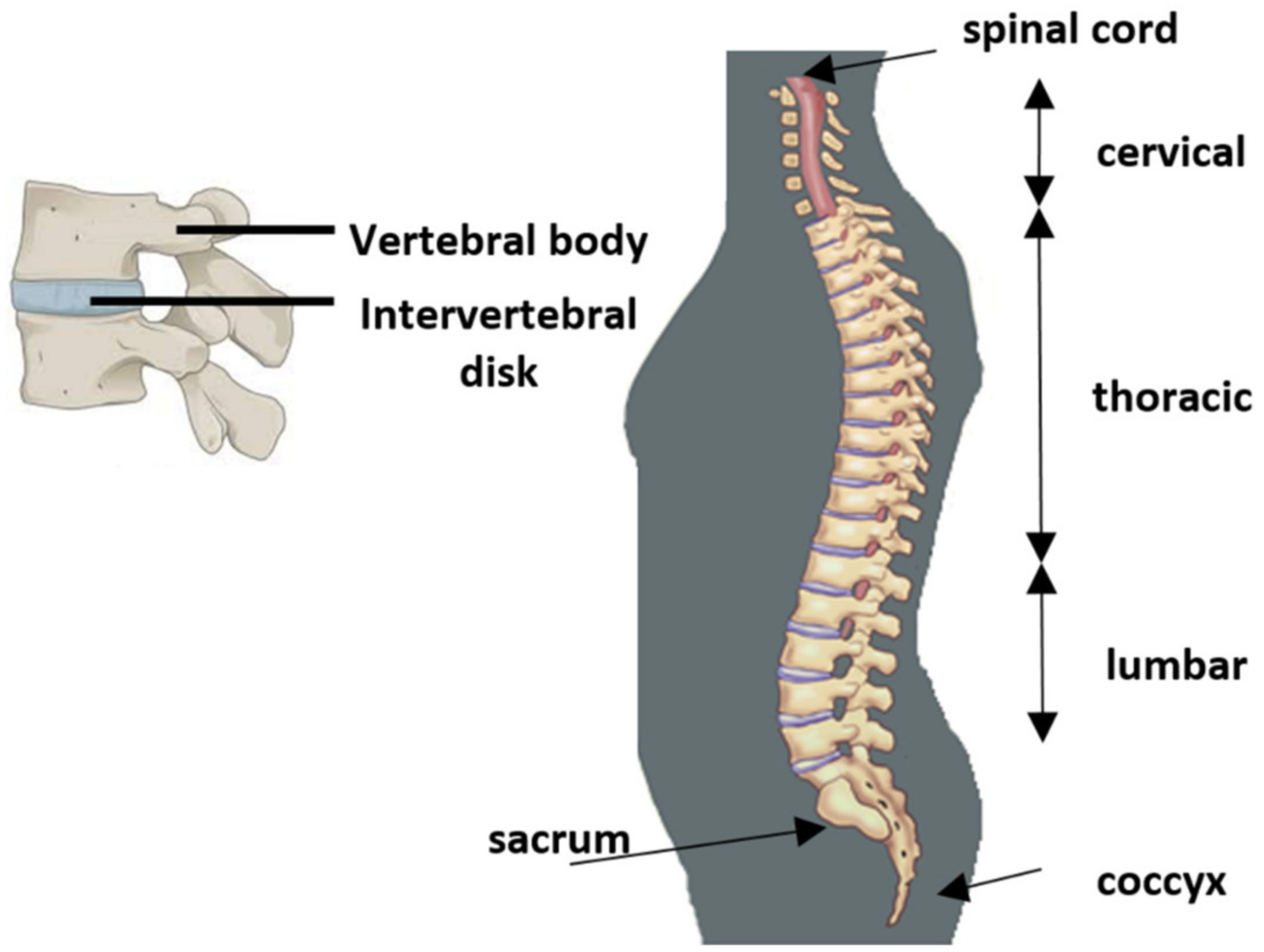
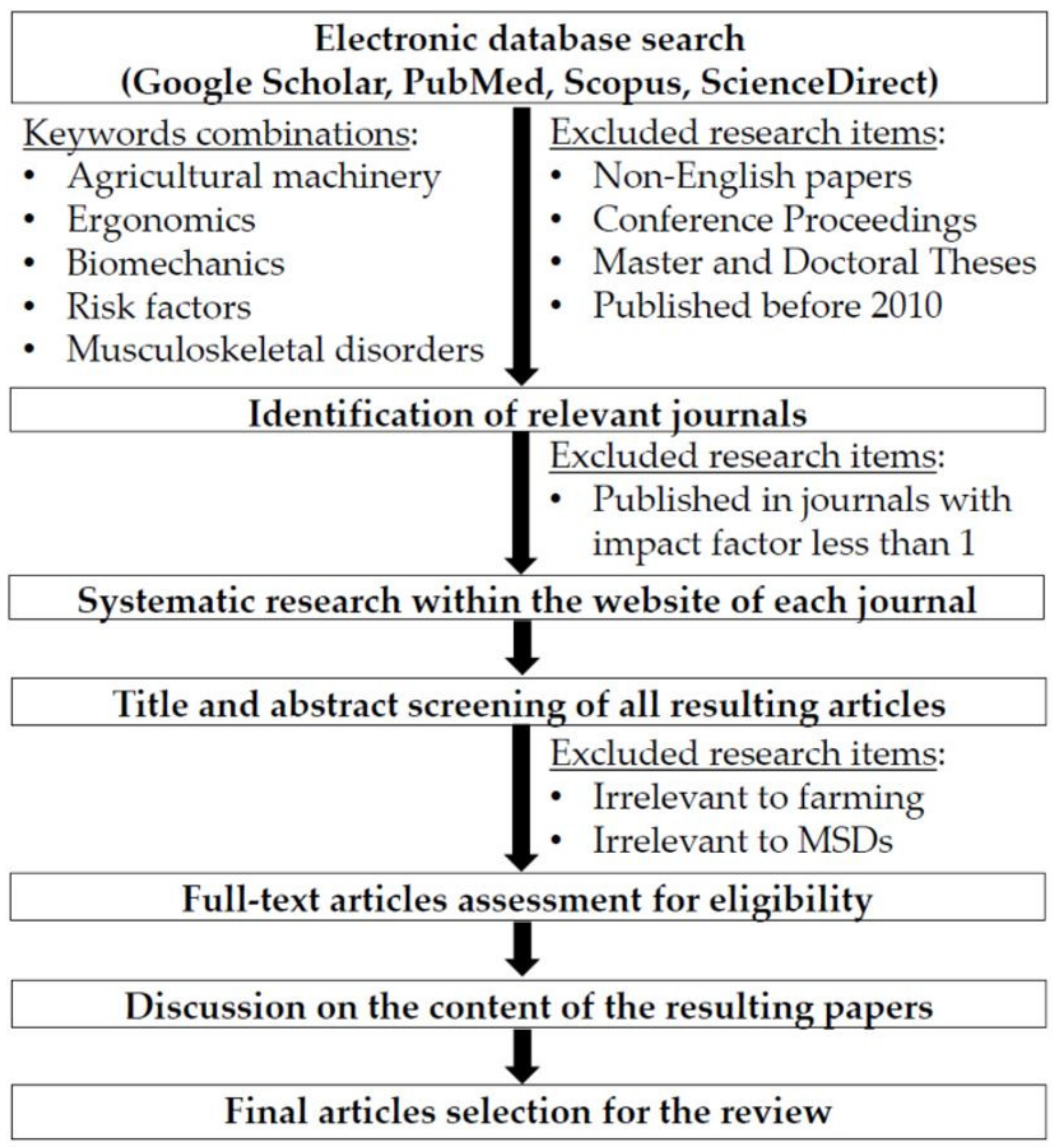
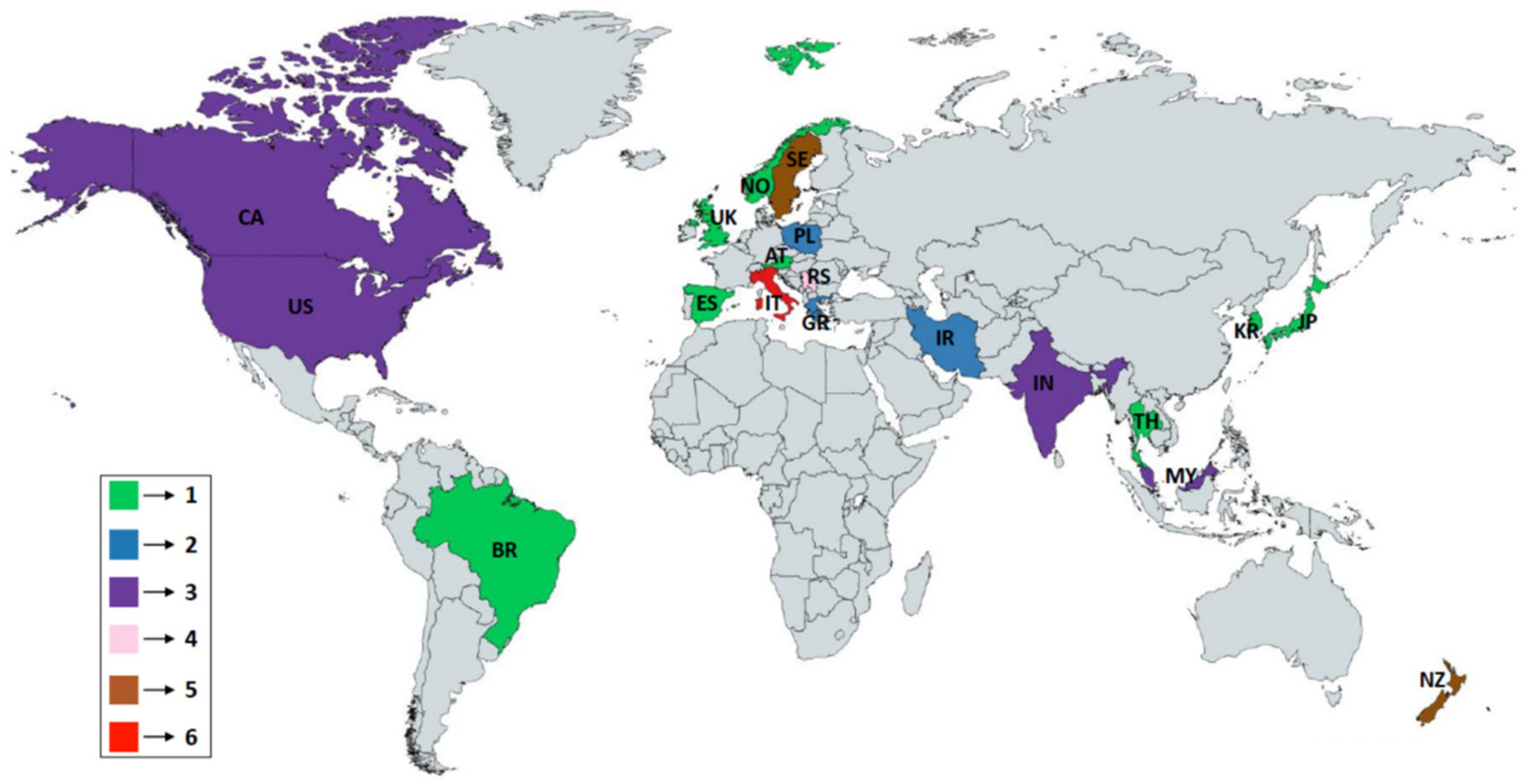
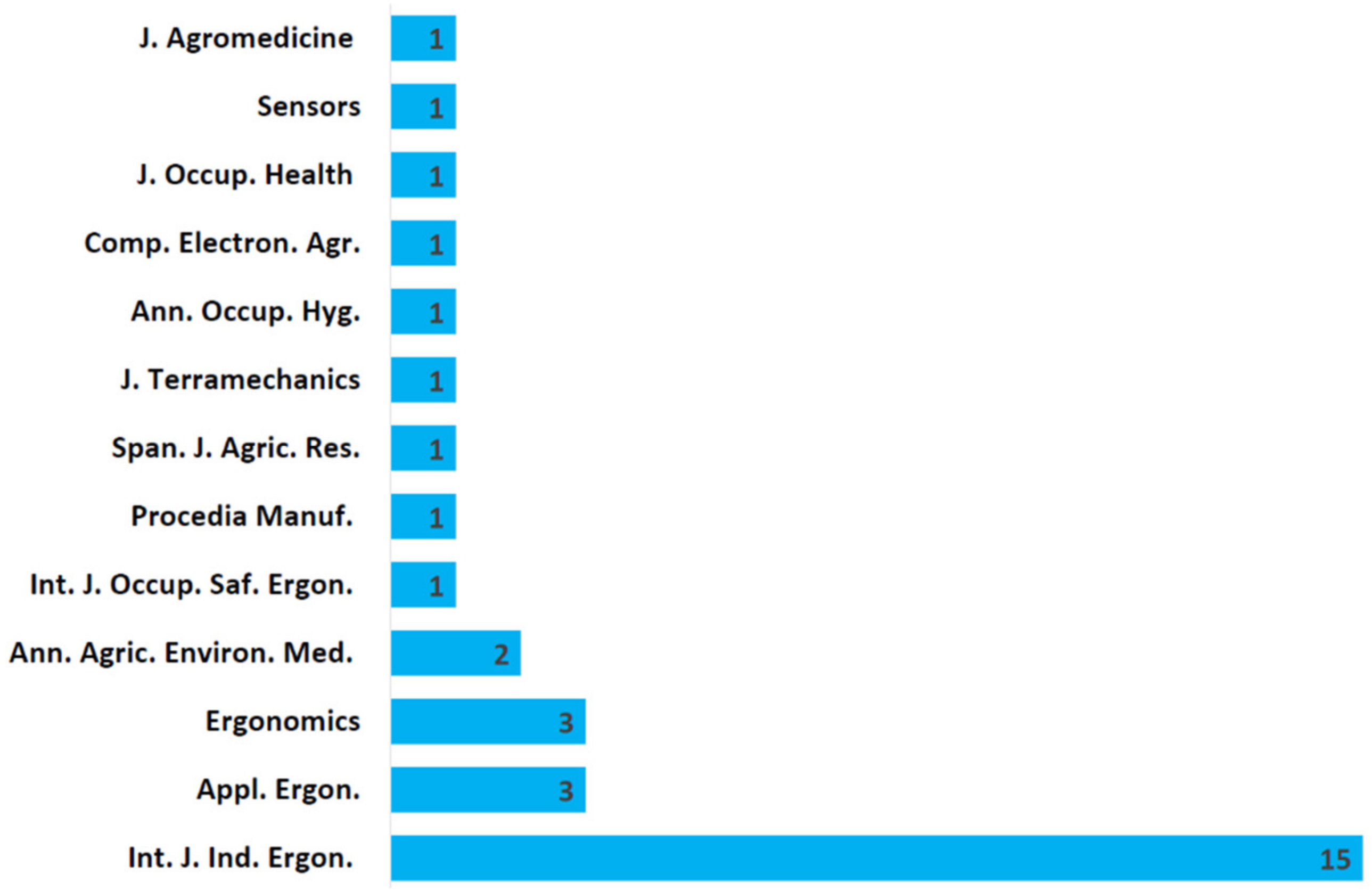
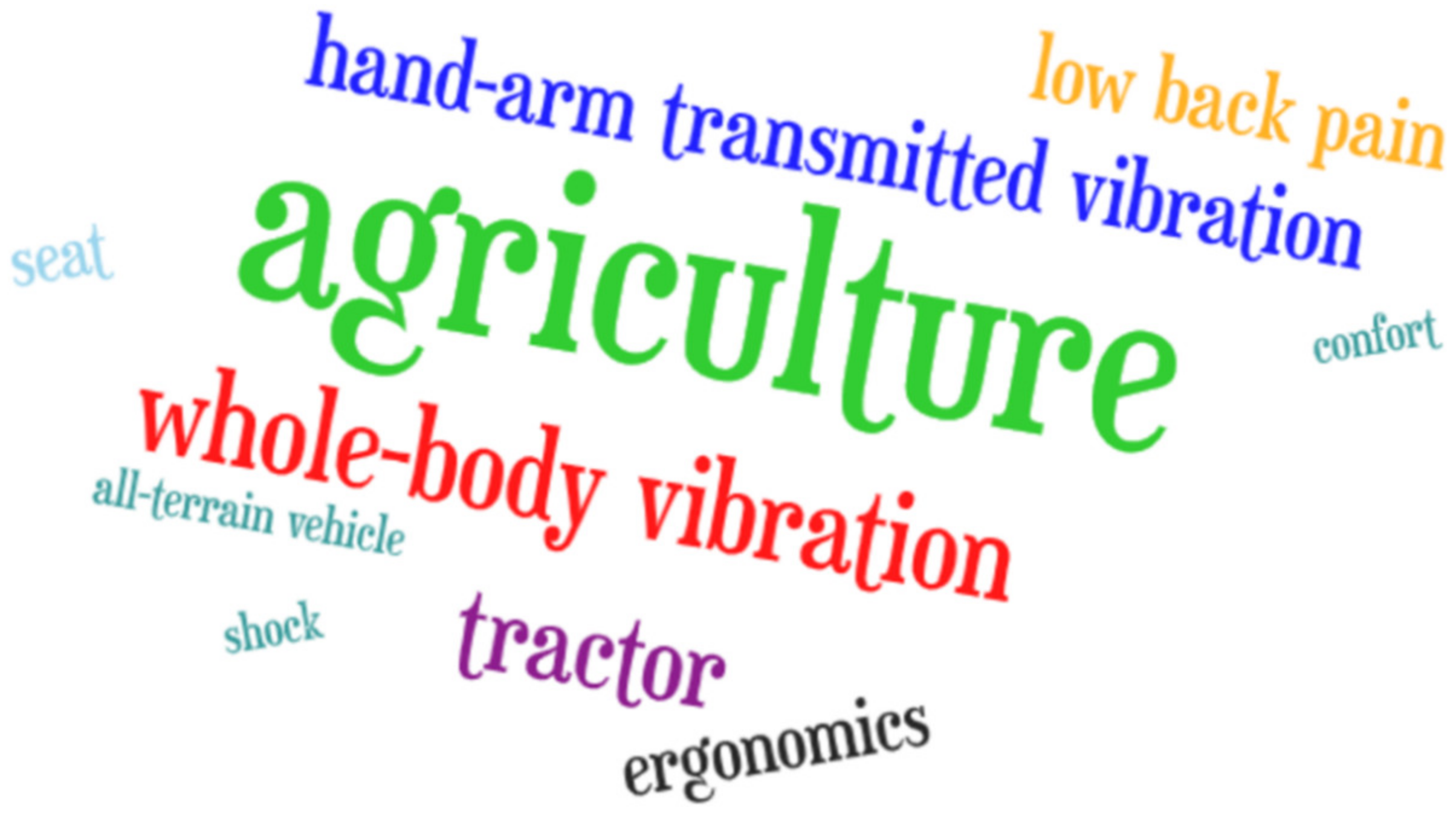
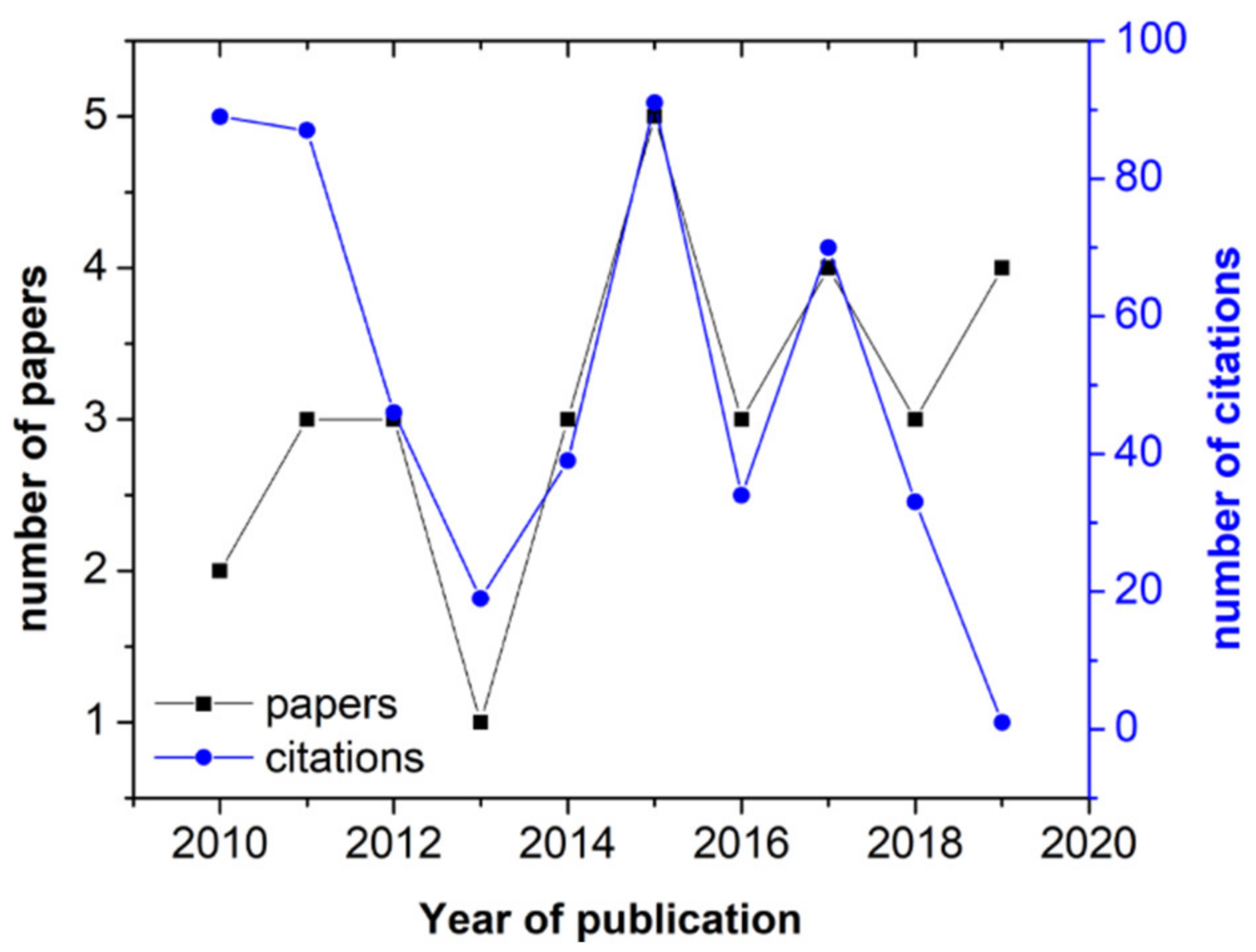
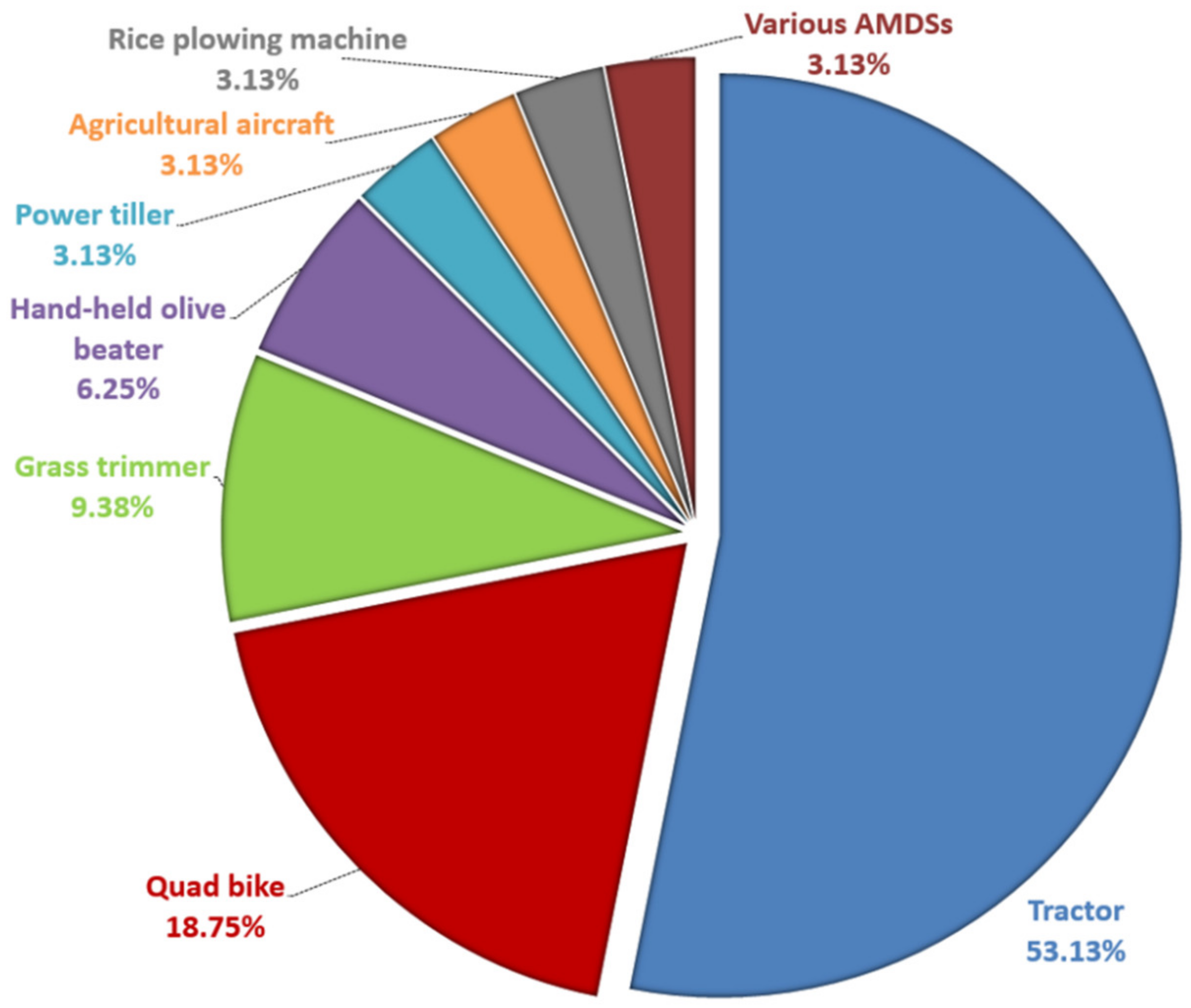
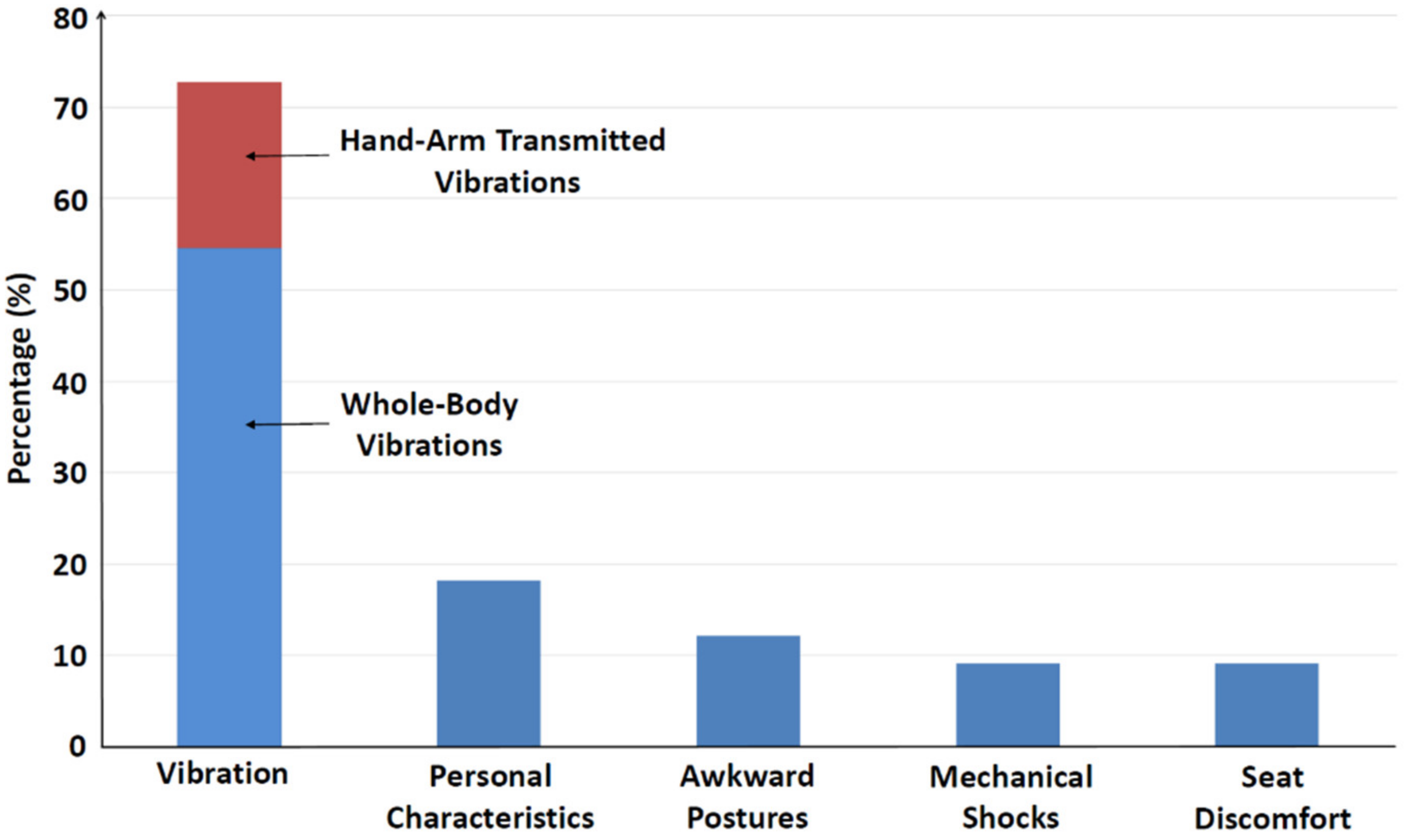
| Reference | External Validity | Internal Validity | Overall, Quality | ||||||||
|---|---|---|---|---|---|---|---|---|---|---|---|
| 1 | 2 | 3 | 4 | 5 | 6 | 7 | 8 | 9 | 10 | 11 | |
| Dewangan et al. [54] | Y | Y | Y | Y | Y | Y | Y | Y | N | Y | ++ |
| Milosavljevic et al. [66] | N | Y | Y | N | Y | N | Y | Y | Y | Y | + |
| Loutridis et al. [59] | N | N | N | N | Y | Y | Y | Y | Y | Y | + |
| Milosavljevic et al. [67] | N | Y | Y | Y | Y | N | Y | Y | Y | Y | ++ |
| Milosavljevic et al. [12] | N | Y | Y | Y | Y | Y | Y | Y | Y | Y | ++ |
| Chaturvedi et al. [14] | N | N | N | N | Y | Y | Y | Y | Y | Y | + |
| Milosavljevic et al. [68] | N | Y | Y | Y | Y | Y | Y | Y | Y | Y | ++ |
| Solecki [57] | N | Y | N | Y | Y | Y | Y | Y | Y | Y | ++ |
| Hao & Ripin [15] | N | N | N | N | Y | Y | Y | Y | Y | Y | + |
| Gomez-Gil [48] | C | C | C | C | Y | Y | C | Y | C | Y | + |
| Morgan & Mansfield [49] | Y | Y | N | Y | Y | N | N | Y | Y | Y | + |
| Swangnetr et al. [77] | N | Y | Y | N | Y | N | Y | Y | Y | Y | + |
| Azmir et al. [71] | Y | Y | Y | Y | Y | N | Y | Y | Y | Y | ++ |
| Langer et al. [18] | C | C | C | C | Y | Y | Y | Y | Y | Y | ++ |
| Mehta & Tewari [62] | C | C | C | C | C | Y | N | Y | C | Y | + |
| Mani et al. [70] | N | N | N | Y | Y | Y | Y | Y | Y | Y | + |
| Tsujimura et al. [79] | N | N | N | N | Y | Y | N | Y | Y | Y | + |
| Azmir et al. [13] | Y | Y | Y | Y | Y | N | Y | Y | Y | Y | ++ |
| Lenzuni et al. [72] | Y | N | N | Y | Y | Y | N | Y | Y | Y | + |
| Gialamas et al. [58] | N | N | N | Y | Y | Y | Y | Y | Y | Y | + |
| Vallone et al. [65] | N | N | N | Y | Y | Y | Y | Y | Y | Y | + |
| Zeng et al. [52] | N | Y | N | N | Y | Y | Y | Y | Y | Y | + |
| Caffaro et al. [64] | N | Y | N | Y | Y | N | Y | Y | Y | Y | + |
| Deboli et al. [60] | N | N | N | Y | Y | Y | Y | Y | Y | Y | + |
| Taghizadeh-Alisaraei [63] | C | C | C | C | C | Y | Y | Y | C | Y | ++ |
| Calvo et al. [33] | N | N | N | Y | Y | Y | Y | Y | Y | Y | + |
| Kim et al. [19] | N | N | N | Y | Y | Y | Y | Y | Y | Y | + |
| Kociolek et al. [69] | N | N | N | Y | Y | Y | Y | Y | Y | Y | + |
| Feyzi et al. [55] | Y | Y | N | Y | Y | Y | Y | Y | Y | Y | ++ |
| Kuta et al. [56] | N | N | N | Y | Y | Y | Y | Y | Y | Y | + |
| Romano et al. [61] | N | Y | Y | Y | Y | Y | Y | Y | Y | Y | ++ |
| Zanatta et al. [78] | N | N | N | Y | Y | N | Y | Y | Y | Y | + |
| Ref. | Year | Country | Machinery | Part. | Methods |
|---|---|---|---|---|---|
| [54] | 2010 | India | Tractor | 379 | Handgrip dynamometer; 16 isometric strength parameters were measured |
| [66] | 2010 | New Zealand | Quad bike | 12 | ΤA, WBVHS Quest; WBV and mechanical shock measurements; Survey on seasonal use and spinal discomfort |
| [59] | 2011 | Greece | Tractor | 1 | Shock absorber, piezoelectric sensor; Vibration was measured for various terrains and operating conditions |
| [67] | 2011 | New Zealand | Quad bike | 130 | ΤA, WBVHS Quest; A seat pad mounted TA measured vibrations and shocks |
| [12] | 2011 | New Zealand | Quad bike | 130 | ΤA, WBVHS Quest; Field study and survey examined the prevalence of loss of control depending on various factors |
| [14] | 2012 | India | Power tiller | 3 | ΤA; Measurements in 3 cases (transportation on farms, rototilling with rotavator and tilling with cultivator); 3 materials at handles to reduce HATV |
| [68] | 2012 | New Zealand | Quad bike | 130 | ΤA, WBVHS Quest; A seat pad mounted TA measured vibrations and shocks; Personal, workplace and vehicle characteristics were collected |
| [57] | 2012 | Poland | Tractor | N/A | TA; The following variables were estimated: total monthly and mean equivalent vibration doses as well as mean equivalent everyday acceleration |
| [15] | 2013 | Malaysia | Grass trimmer | 10 | ΤA, FFT analyzer; Transversal deflection, nodal technique and operating deflection shape analysis of the grass trimmer |
| [48] | 2014 | Spain | Tractor | N/A | Piezoelectric accelerometer; Geometrical and experimental examination |
| [49] | 2014 | UK | Tractor | 83 | Quest; Experts’ opinion on the influence of combined exposure to WBV and trunk rotation |
| [77] | 2014 | Thailand | Rice plowing machine | 24 | Grip force sensor, EMG; Simulated plowing operation including walking on uneven and even terrain with suggested vertical handles and conventional horizontal ones |
| [71] | 2015 | Malaysia | Grass trimmer | 204 | Dynamometer (for measuring hand grip strength), physical observation for color changes in the fingers, HAVS Quest |
| [18] | 2015 | Norway | Tractor | N/A | WB accelerometer; Experimental measurements on a specific vehicle for different combinations of driving uphill and downhill |
| [62] | 2015 | India | Tractor | N/A | Biomechanical model to calculate the shear and compressive loads at L4/L5 (lumbar vertebra) of the operator with seats having different backrest cushions and seat pans |
| [70] | 2015 | New Zealand | Quad bike | 34 | ΤA; The postural control was found from displacements of the center of pressure at 3 different time periods |
| [79] | 2015 | Japan | Various AMDSs | 1 | TA, Quest; Measurement of accelerations at the seat base and at the seat pan in 4 vehicles having various implements attached over one year |
| [13] | 2016 | Malaysia | Grass trimmer | 168 | HAVS Quest; Survey on HATV exposure and symptoms |
| [72] | 2016 | Italy | Handheld olive beater | 60 | TA, Round Robin test; Tasks typically done during olive harvesting were performed via a tree simulator and field tests |
| [58] | 2016 | Greece | Tractor | N/A | Piezoelectric accelerometer, shock absorber; Combinations of 3 different tractors, 3 implements and 4 speeds |
| [65] | 2016 | Italy | Tractor | 1 | TA, shock absorbers; 6 different track-laying tractors having identical rototilling machine |
| [52] | 2017 | Canada | Tractor | 40 | TA, Quest; Vibration measurements were performed at the operator-seat interface with a TA in a seat pad from rubber |
| [64] | 2017 | Sweden | Tractor | 9 | Quest, interview; Senior farmers’ opinion about their working life quality, problems in interacting with technological innovations, risk and safety issues |
| [60] | 2017 | Italy | Tractor | 1 | TA; Field tests were performed with the tractor moving on various grounds, at 2 forward speeds and tire pressures and with dissimilar tractor masses |
| [63] | 2017 | Iran | Tractor | N/A | TA; Analysis of shocks transmitted from the tractor seat using statistical methods and vibration signals |
| [33] | 2018 | Italy | Handheld olive beater | 5 | ΤA, OCRA method; 3 dissimilar electric olive beaters whose head had oscillating sticks |
| [19] | 2018 | USA | Tractor | 11 | TA; Examination of the differences between a single- and multi-axial suspension seat and muscle activity of the low back, shoulders and neck |
| [69] | 2018 | Canada | Quad bike | 10 | ΤA, triaxial gyroscope; Measurement of vibration exposure at the head and seat |
| [55] | 2019 | Iran | Tractor | 364 | Quest, anthropometric measurement devices; Hand, leg and torque strengths were measured and compared against recommended values |
| [56] | 2019 | Poland | Tractor | 10 | EMG; The lowest workload regarding the arm, wrist and forearm was determined, taking into account the elbow angle and the position of the steering column |
| [61] | 2019 | Italy | Tractor | 8 | Pressure sensors; 3 different tractor seats were used during harrowing, ploughing and haying |
| [78] | 2019 | Brazil | Aircraft | 4 | ΤA, musculoskeletal quest; measurement of the pilots’ exposure to WBV during the flight and survey on musculoskeletal symptoms on the spine |
| Ref. | Main Results | Risk Factors | Authors’ Suggestions |
|---|---|---|---|
| [54] | Isometric muscle strength of the right limbs was significantly higher than the corresponding left ones | Incorrect design of handling tools | Design of tractor controls based on isometric muscular strength data |
| [66] | The WBV and mechanical shocks were higher than the permitted limits; Low back pain was the most reported complaint | WBV, mechanical shocks | Shock absorbers |
| [59] | Electronic speed regulation is suggested in typical field tasks, while it should not be used in transportation on asphalt roads | WBV | Electronic speed regulation in typical field tasks |
| [67] | Vibration dose values and mechanical shocks exceeded standard limit thresholds; Lower and upper back pains were reported | WBV, mechanical shocks, age, body mass, driving duration | Shock absorbers, reduction of velocity and driving duration |
| [12] | Heavier and taller operators driving in difficult terrains and at high speeds should be particularly vigilant for risk of a loss of control | WBV, body height and mass, speed and distance, non-flat terrain | Management strategies for decreasing risks |
| [14] | The highest vibration was along x-direction; The maximum vibration reductions occurred with rubber handles; Interventions decelerated the occurrence of white finger syndrome | HATV | Rubber handles |
| [68] | A mixture of operator’s height, mechanical factors and type of terrain can worsen the impact of body mass on vibration exposure | WBV, Body height and mass, sheep farms | Anthropometrics should be considered in the designing of seating and suspension systems |
| [57] | The highest total vibration doses occurred in August and April; The maximum mean daily exposure appeared during April, August, September and October | WBV | Management strategies for private farmers |
| [15] | Decrease of acceleration in all axes and total vibration values were noted by using the 2 tuned vibration absorbers | HATV | Control of handle vibration by node technique |
| [48] | Lateral vibrations can exceed the vertical ones, while they increase linearly with the tractor-seat height above the ground | Lateral vibrations | Lowering tractor-seat height above the ground |
| [49] | WBV and trunk rotation simultaneously exposure increases the risk for low back pain and discomfort in the right shoulder and thighs | WBV combined with trunk twist | Consideration of operators’ feedback on equipment design |
| [77] | Tools facilitating a neutral wrist and symmetrical body postures can help to increase the efficiency of muscle use and reduce MSDs | Awkward wrist and body posture | Vertical handle design |
| [71] | Prolonged vibration exposure resulted in loss of hand grip strength, fingers’ numbness and blanching | HATV | The chronic health effect should be considered when evaluating disabilities |
| [18] | The higher WBV was observed during downhill driving with 4-wheel drive | Longitudinal WBV | Manual or automatic control of 4-wheel drive |
| [62] | Coir cushion (80 mm thickness) and a high-density polyurethane foam (44 mm thickness) demonstrated the maximum and minimum compressive forces, respectively | Compressive and shear loads on lumbar vertebra | Biomechanical models for design of tractor seat, seat backrest cushion |
| [70] | Significant increase of the center of pressure for the lifting task | Postural control displacements | Postural control alterations to lessen acute exposures |
| [79] | WBV levels exceeded the Japanese and European threshold limits | WBV, heavy implements, high velocities | New health management strategies |
| [13] | Positive HATV symptoms relationships between the low-moderate and high exposure groups | HATV | Safety and health awareness programs |
| [72] | The simulated olive harvesting performed via this Round Robin test proved to be consistent with field tests | HATV | Round Robin test could be a viable basis for future research |
| [58] | Tractors play a key role in the development of lateral vibrations, while the implements in the horizontal ones; The plough showed the highest vibration | WBV | Optimal combination of tractor and implement |
| [65] | The daily vibration values were higher than the permitted ones; The characteristics of the soil affected only the vibration in the z axis | WBV, soil type | Soil type should be considered |
| [52] | The maximum vibrations appeared in the vertical axis; 41.4% of these measurements were within or above the caution zone | WBV | Workplace information for the total work period |
| [64] | Mounting/dismounting the tractor as well as awkward trunk postures seems to cause back pains; An additional step and rear-view cameras and mirrors were mentioned to be particularly helpful | Mounting/dismounting the tractor, twisted postures, overconfidence | Training activities and design solutions for senior farmers |
| [60] | The vibrations on the seat along the x and y axes are affected by the pitching and rolling movements | WBV | Decrease of the rolling and pitching effects by using suspension systems |
| [63] | Ground roughness and engine generate vibrations within the 0–30 Hz and 50–200 Hz range, respectively; Kurtosis method better demonstrated the difference between the signals | WBV, mechanical shocks | Re-determining the practical limits |
| [33] | In all experiments both the HATV and OCRA scores indicated values beyond the admitted limits | HATV | Use of reliable vibration data, not only by subjective perceptions |
| [19] | Multi-axial suspension can decrease the lateral vibration and the associated pain in the neck and low back | WBV | Multi-axial seat suspension systems |
| [69] | The vertical vibrations were higher at head and neck than the seat. | Head and neck vibration | Suspension systems should consider both seat and head data |
| [55] | Inappropriateness of the international standards in the case of the isometric muscle strength in Iran | Seat discomfort | Design of tractor controls based on isometric muscular strength data |
| [56] | The most convenient position for the hands was at the elbow angle of 100° and when the steering column inclination angle was 50° | Seat discomfort | Design of tractor controls based on the comfort of the operator |
| [61] | The analyzed pressure indices are useful for comparing seats with the aim of assuring comfort in static and dynamic situations | Seat discomfort | Cushion-seat development based on intelligent automatic controller |
| [78] | In few situations, some over the limit values were observed; 62% of the participants reported some discomfort of the spine throughout the last 12 months | WBV | Improving the aircraft’s cabin and controlling the flight time |
© 2020 by the authors. Licensee MDPI, Basel, Switzerland. This article is an open access article distributed under the terms and conditions of the Creative Commons Attribution (CC BY) license (http://creativecommons.org/licenses/by/4.0/).
Share and Cite
Benos, L.; Tsaopoulos, D.; Bochtis, D. A Review on Ergonomics in Agriculture. Part II: Mechanized Operations. Appl. Sci. 2020, 10, 3484. https://doi.org/10.3390/app10103484
Benos L, Tsaopoulos D, Bochtis D. A Review on Ergonomics in Agriculture. Part II: Mechanized Operations. Applied Sciences. 2020; 10(10):3484. https://doi.org/10.3390/app10103484
Chicago/Turabian StyleBenos, Lefteris, Dimitrios Tsaopoulos, and Dionysis Bochtis. 2020. "A Review on Ergonomics in Agriculture. Part II: Mechanized Operations" Applied Sciences 10, no. 10: 3484. https://doi.org/10.3390/app10103484






